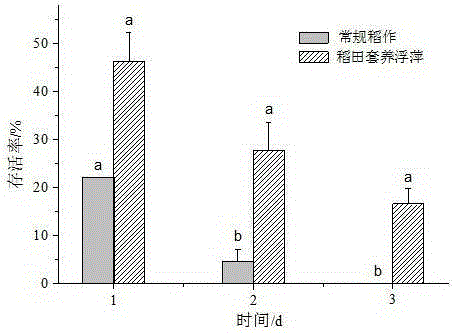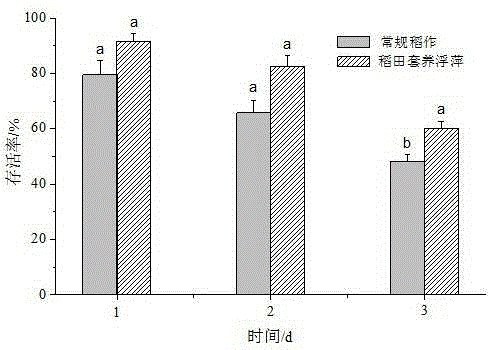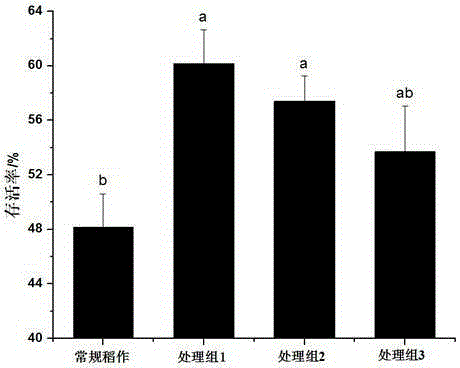Method for interplanting duckweed in rice field to reduce damages to paddy rice caused by ampullaria gigas
A technology of apple snails and paddy fields, applied in rice cultivation, botany equipment and methods, fish farming, etc., to overcome environmental pollution and agricultural product safety production problems, and ensure food safety and environmental safety
- Summary
- Abstract
- Description
- Claims
- Application Information
AI Technical Summary
Problems solved by technology
Method used
Image
Examples
Embodiment 1
[0023] The rice variety selected in this example is Huanghuazhan (Yueshendao 2005010), and the duckweed is green duckweed collected from wild rice fields. The test site is located on the outdoor balcony of the Agricultural College of South China Agricultural University, in a plastic box with a size of 77cm×50cm×36cm. The bottom of the plastic box is paddy soil, the soil layer is about 10cm, and the water depth is about 5cm. 4 rice seedlings are used as 1 hole, and 9 hole seedlings are evenly inserted into each box according to the specification of 20cm×15cm. There were 6 boxes in the test, 3 of which were added with 15g of fresh duckweed on the day of transplanting, as the treatment group, and the other 3 as the control group. Put 8 apple snails in each box, 2 shell heights of 15-20mm, 20-25mm, 25-30mm, and 30-35mm respectively. After the above-mentioned number of apple snails were put in, the damage of rice seedlings was counted at the same time every day, and the whole rice...
Embodiment 2
[0027]The rice variety selected in this example is Huanghuazhan (Yueshendao 2005010), and the duckweed is collected from a field paddy field. The test site is located on the outdoor balcony of the Agricultural College of South China Agricultural University. It is carried out in a plastic box with a size of 77cm×50cm×36cm. The bottom of the box is paddy soil, the soil layer is about 10cm, and the water depth is about 5cm. Rice seedlings are 1 hole with 4 plants, and each box is evenly inserted into 9 holes of 30-day-old rice seedlings according to the specification of 20cm×15cm. A total of 12 boxes were used in the test, and 8 apple snails were put into each box after transplanting rice, with shell heights of 15-20mm, 20-25mm, 25-30mm, and 30-35mm, respectively. Taking apple snails as the time node, 15g of fresh duckweed was added to 3 plastic boxes at the same time as apple snails, as treatment group 1; treatment group 2 and treatment group 3 each had 3 boxes, which were added...
Embodiment 3
[0030] The rice variety selected in this example is Meixiangzhan (Yueshendao 2006009). The test site is located on the outdoor balcony of the Agricultural College of South China Agricultural University. It is carried out in a plastic box with a size of 38cm×27cm×13cm. Three gradients are set for soil and water depth, which are set to 0cm, 2cm, and 5cm respectively. 15-day-old and 30-day-old seedlings were selected for the experiment, and 120 15-day-old or 30-day-old seedlings were inserted into plastic boxes in different water layers. After the rice is planted, put 2 active apple snails of the same snail grade in each box. Three snail grades are selected for the apple snails, namely the young snail (shell height 10-15mm), medium snail (shell height 15-20mm), Become a snail (shell height>20mm). The three factors of different water depths, different day-old rice and different snail grades crossed each other, and each treatment was repeated 4 times. After 24 hours, the effects o...
PUM
 Login to View More
Login to View More Abstract
Description
Claims
Application Information
 Login to View More
Login to View More - R&D
- Intellectual Property
- Life Sciences
- Materials
- Tech Scout
- Unparalleled Data Quality
- Higher Quality Content
- 60% Fewer Hallucinations
Browse by: Latest US Patents, China's latest patents, Technical Efficacy Thesaurus, Application Domain, Technology Topic, Popular Technical Reports.
© 2025 PatSnap. All rights reserved.Legal|Privacy policy|Modern Slavery Act Transparency Statement|Sitemap|About US| Contact US: help@patsnap.com



